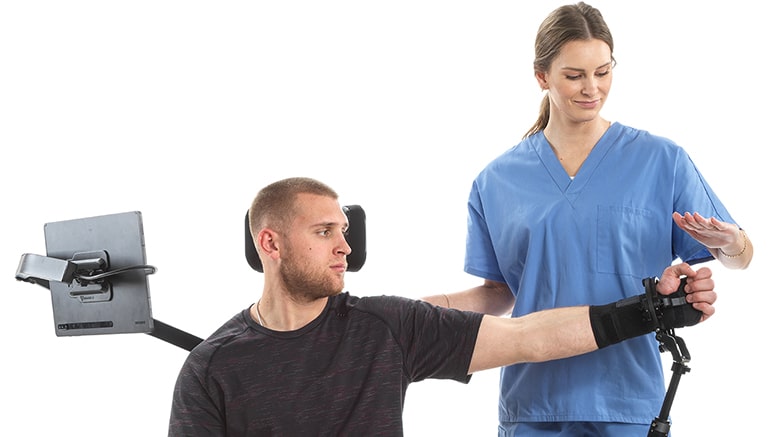Multidisciplinary Technology for Shoulder Management
Physical Therapists
Reinvigorate your approach to shoulder rehabilitation with advanced technology
Sports Medicine
Don’t let shoulder injuries prolong or prevent an athlete’s return to competition
Frequently Asked Questions Regarding Technology for Shoulder Rehabilitation
Technology for shoulder rehabilitation refers to the use of advanced devices and digital solutions designed to aid in the recovery of shoulder injuries. Such technologies, like our Humero Tech C1 at TitinKM Biomedical, may offer targeted exercises for strengthening the shoulder muscles, including the rotator cuff, and provide real-time feedback to help enhance the effectiveness of physical therapy and rehabilitation processes.
In shoulder rehabilitation, technology can bring about a more effective and efficient recovery process. Advanced devices can provide objective measurements of strength and range of motion, permitting precise monitoring of progress. Furthermore, technology can offer customizable routines for strengthening and therapy, ensuring that the rehabilitation process is tailored to the patient’s specific needs.
Usability is crucial in technology for shoulder rehabilitation. It ensures that devices are user-friendly and easy to operate, whether by healthcare professionals or patients. A high level of usability can enhance patient engagement, compliance, and overall effectiveness of the rehabilitation process.
Yes, many shoulder rehabilitation technologies are designed with home use in mind. These devices can provide guided exercises and therapies, allowing patients to continue their rehabilitation and strengthening routines at home, supplementing in-person physical therapy sessions.
Virtual reality (VR) in shoulder rehabilitation can provide a more immersive and interactive experience for patients. It can make therapy sessions more engaging and enjoyable, which can increase patient compliance and potentially lead to better outcomes. VR can simulate different environments and situations for therapy, making exercises more realistic and relevant.
Technology for shoulder rehabilitation aids recovery by providing objective measurements of strength and range of motion, facilitating targeted and personalized exercise routines, and enabling real-time feedback and progress tracking. These features help clinicians create and adjust treatment plans based on quantifiable data, potentially leading to better prognosis and faster recovery.
Absolutely, technology for shoulder rehabilitation is particularly beneficial for rotator cuff injuries. Devices like the Humero Tech C1 from TitinKM Biomedical offer targeted exercises to strengthen the rotator cuff muscles, improve flexibility, and increase range of motion. These exercises can promote healing and help patients regain normal shoulder function.
Technology for shoulder rehabilitation enhances traditional physical therapy by providing objective data on patient progress, facilitating the creation of personalized exercise programs, and offering real-time feedback. This can make the therapy more effective and efficient, potentially speeding up the recovery process and improving outcomes.
Yes, technology for shoulder rehabilitation is designed to be used by people of all ages, from young adults to seniors. The levels of exercises and therapies can be adjusted to suit the individual’s fitness level, age, and specific health conditions, ensuring a safe and effective rehabilitation process.
Acceptability refers to how well patients and healthcare providers embrace the use of technology in shoulder rehabilitation. High acceptability indicates that the technology is well-received, used consistently, and considered beneficial in the recovery process. As such, user-friendly interfaces and effective results are crucial for high acceptability.
While technology for shoulder rehabilitation can significantly support and improve the recovery process, it does not replace the need for a physical therapist. These professionals provide expert guidance, monitoring, and adjustments of the treatment plan based on the patient’s progress and feedback. Technology serves as a valuable tool to enhance the services provided by physical therapists.
When used correctly and under professional guidance, technology for shoulder rehabilitation is generally safe. Most devices are designed with safety measures in place and provide instructions to ensure they are used correctly and effectively.
While certain technologies, like the Humero Tech C1, are specifically designed for shoulder rehabilitation, the principles of many rehabilitation technologies can be adapted for use in other parts of the body. However, it’s important to use devices as intended and under professional guidance to ensure safety and effectiveness.
Future developments in technology for shoulder rehabilitation may include further integration of artificial intelligence for personalized treatment plans, more immersive virtual reality exercises, and the use of wearable technology for continuous monitoring of progress. These advancements aim to make shoulder rehabilitation more efficient, effective, and personalized.
Shoulder rehabilitation technology, like the Humero Tech C1, is typically provided through healthcare providers such as physical therapy clinics and hospitals. If you’re interested in using technology for shoulder rehabilitation, consult with your healthcare provider or contact us at TitinKM Biomedical to learn about our innovative solutions.


